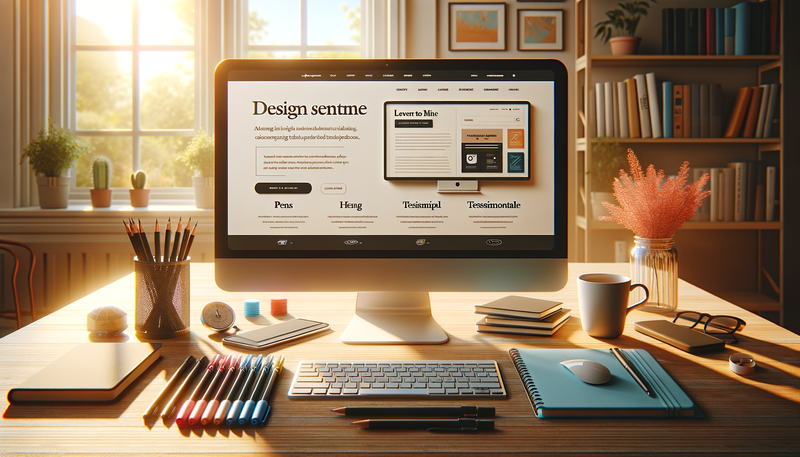Designing Effective Landing Pages: Key Elements and Best Practices
Creating effective landing pages is crucial for converting visitors into customers. This article delves into the key elements and best practices for designing high-converting landing pages. We'll explore essential components, layout strategies, and psychological triggers that can significantly boost your conversion rates. By implementing these techniques, you'll learn how to optimize your landing pages for maximum effectiveness, ensuring that your marketing efforts yield the best possible results. Whether you're new to landing page design or looking to refine your existing pages, this comprehensive guide will provide valuable insights to help you create compelling, conversion-focused landing pages that drive business growth.Table of Contents:
-
The Importance of Clear and Compelling Headlines
- Optimizing Your Call-to-Action (CTA) for Maximum Impact
- Leveraging Social Proof and Testimonials
- Designing for Visual Appeal and Clarity
- Crafting Persuasive and Benefit-Driven Copy
- Optimizing Form Design for Higher Conversion Rates
- Implementing A/B Testing and Continuous Improvement
- Optimizing Your Call-to-Action (CTA) for Maximum Impact
- Leveraging Social Proof and Testimonials
- Designing for Visual Appeal and Clarity
- Crafting Persuasive and Benefit-Driven Copy
- Optimizing Form Design for Higher Conversion Rates
- Implementing A/B Testing and Continuous Improvement

The Importance of Clear and Compelling Headlines
Your landing page headline is the first thing visitors see, making it crucial for grabbing attention and conveying your value proposition. A well-crafted headline should be clear, concise, and compelling, instantly communicating the main benefit of your offer. Use action-oriented language and focus on the problem you're solving or the value you're providing. Consider using numbers or statistics to add credibility and intrigue. For example, 'Boost Your Conversion Rates by 50% with Our Proven Strategies' is more engaging than a generic 'Welcome to Our Website.' A/B testing different headlines can help you identify the most effective options for your target audience. Do you need a website? Want to build a website but don't know where to start? Our website builder is the perfect solution. Easy to use, and with the ability to customize to fit your business needs, you can have a professional website in no time.
Optimizing Your Call-to-Action (CTA) for Maximum Impact
The call-to-action (CTA) is the centerpiece of your landing page, guiding visitors towards the desired action. To create an effective CTA, use action-oriented verbs like 'Get,' 'Start,' or 'Join' combined with benefit-driven language. Make your CTA button stand out visually using contrasting colors and adequate white space.Consider the placement of your CTA carefully - above the fold is often effective, but testing different locations can yield insights. For longer pages, include multiple CTAs throughout the content. Experiment with different button shapes, sizes, and copy to find the most compelling combination. Remember to create a sense of urgency or scarcity when appropriate, such as 'Limited Time Offer' or 'Only 5 Spots Left,' to encourage immediate action.
Leveraging Social Proof and Testimonials
Social proof is a powerful psychological trigger that can significantly boost conversions. Incorporate customer testimonials, reviews, and case studies to build trust and credibility. Use real photos and full names when possible to enhance authenticity.Showcase logos of well-known clients or media mentions to further establish your reputation. If applicable, display numerical social proof such as the number of satisfied customers or percentage of positive reviews. Consider using video testimonials for even greater impact. Strategically place social proof elements near your CTA or in areas where visitors might hesitate, providing that extra push towards conversion.
Building a website with SITE123 is easy
Designing for Visual Appeal and Clarity
The visual design of your landing page plays a crucial role in its effectiveness. Aim for a clean, uncluttered layout that guides the visitor's eye towards key elements. Use a consistent color scheme that aligns with your brand and creates visual hierarchy.Incorporate high-quality, relevant images or videos that support your message and showcase your product or service. Break up text with subheadings, bullet points, and short paragraphs to improve readability. Use white space effectively to prevent overwhelming visitors with information. Ensure your page is mobile-responsive, as a significant portion of traffic may come from mobile devices. Pay attention to loading speed, as slow-loading pages can significantly impact conversion rates.
Crafting Persuasive and Benefit-Driven Copy
Your landing page copy should be concise, compelling, and focused on the benefits of your offer. Start with a strong value proposition that clearly communicates what sets you apart from competitors. Use the inverted pyramid style of writing, presenting the most important information first.Address your audience's pain points and explain how your product or service solves their problems. Use bullet points to highlight key features and benefits, making the information easily scannable. Incorporate persuasive elements such as storytelling, emotional appeals, and FOMO (fear of missing out) where appropriate. Always focus on the 'what's in it for me' aspect from the customer's perspective. End with a strong closing argument and a clear call-to-action that reinforces the benefits of taking action.
Optimizing Form Design for Higher Conversion Rates
If your landing page includes a form, its design can significantly impact conversion rates. Keep forms as short as possible, asking only for essential information. Use a single-column layout for better usability and faster completion.Consider using multi-step forms for longer forms, breaking the process into manageable chunks. Clearly label form fields and use placeholder text to provide examples of expected input. Implement real-time validation to catch errors early and reduce frustration. If possible, offer social login options to simplify the process further. Test different form layouts, field orders, and button text to optimize performance. Remember, every additional field can potentially decrease conversion rates, so be judicious in your information requests.
Implementing A/B Testing and Continuous Improvement
Creating an effective landing page is an ongoing process of testing and refinement. Implement A/B testing to compare different versions of your page and identify which elements perform best. Test one variable at a time, such as headline, CTA button color, or image placement, to accurately measure the impact of each change.Use heat mapping and user recording tools to gain insights into visitor behavior and identify areas for improvement. Analyze your conversion funnel to pinpoint where visitors are dropping off and address those issues. Regularly review your analytics data to track performance metrics and inform your optimization efforts. Remember that what works for one audience may not work for another, so continue testing and refining your landing pages over time to maintain and improve their effectiveness.





